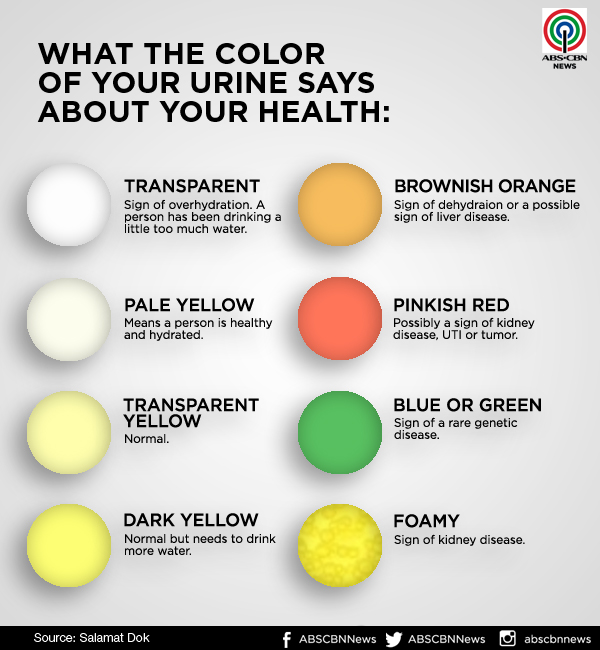Human urine has been a useful tool of diagnosis since the earliest days of medicine. The color, density and smell of urine can reveal much about the state of our health.
Doctors request a urine test to help diagnose and treat a range of conditions including kidney disorders, liver problems, diabetes and infections. Testing urine is also used to screen people for illicit drug use and to test if a woman is pregnant.
Urine can be tested for particular proteins, sugars, hormones or other chemicals, certain bacteria and its acidity or alkalinity.
Doctors can also tell a lot from how your urine looks and smells. For example dark urine could be a sign of dehydration; a cloudy appearance may suggest infection; if the urine is a reddish color there may be blood in it; and a sweet smelling urine can be a sign of diabetes.
Transparent
Looks like: Clear urine CAN mean you’re healthy. Typically, the healthier you are, the lighter your urine color. While you would think that clear urine would mean a well hydrated, healthy body, it may actually be a symptom of some other issues. The ideal healthy urine color is actually a straw yellow color.
Light yellow urine color
Looks like: The amount of water you drink influences whether the color is a pale yellow or a dark amber. People who drink more water and stay hydrated typically produce more dilute, pale urine compared to those who are dehydrated or consume less water.
Cloudy
Looks like: Cloudy or foamy urine may occur occasionally due to mild dehydration; when it occurs in the absence of symptoms and goes away rapidly, it is usually of little consequence. Certain conditions can cause excess protein or crystalline substances in the urine, causing it to persistently appear cloudy or foamy.
Medium yellow urine color
Looks like: Lemonade. You probably are dehydrated. You should drink some water.
Dark yellow
Looks like: Blood in the urine, also known as Haematuria, can cause darker urine. Haemolytic Anemia can cause dark yellow urine color. Hepatitis can cause a darker urine color. Hepatitis is an inflammation of your liver, and it’s usually caused by a viral infection or some medications or even alcohol consumption.
Orange
Looks like: Orange urine can be a symptom of eating carotenoids (foods and supplements containing beta-carotene), infection, dehydration, certain medications, injury, or disease. Urine that appears orange results from changes in the contents of the urine. It may occur in conditions affecting the urinary tract itself or along with more generalized conditions, such as infection and cancer.
Pink
Looks like: Factors that can cause urinary blood (hematuria) include urinary tract infections, enlarged prostate, cancerous and noncancerous tumors, kidney cysts, long-distance running, and kidney or bladder stones. Foods, beets, blackberries and rhubarb can turn urine red or pink.
Darker pink
Looks like: Dark brown but clear urine is a sign of a liver disorder such as acute viral hepatitis or cirrhosis, which causes excess bilirubin in the urine. Pink, red, or lighter brown urine can be caused by: Beets, blackberries, or certain food colorings.
Dark pink
Looks like: The presence of old blood is truly worrying since it suggests a significant amount of blood. It also might indicate that whatever’s triggering the bleeding has actually been around for a while.
Brown
Looks like: Coke. If you notice that your urine is brown, a good first step is to drink more water to rule out dehydration as the culprit. You should also think about the foods you’ve eaten and the medicines you’ve taken. If you’ve eaten a food or taken a medicine known to tint urine brown, you’ve likely found your cause.
Blue/Green
Looks like: Some brightly colored food dyes can cause green urine. Dyes used for some tests of kidney and bladder function can turn urine blue. A number of medications produce blue or green urine, including amitriptyline, indomethacin (Indocin) and propofol (Diprivan).
Culled from Natural Healthy Habit













